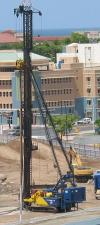

| http://people.csail.mit.edu/jaffer/Wells |
Science in the TrenchesIn Memoriam Harold G. Jaffer (1904-1995) |
After a career as a garment buyer in New York, Harold moved to Miami Florida in 1950. He joined his friend Caryl Stern in the irrigation business; and continued after Stern retired. Initially, they served homeowners by installing wells, pumps, and lawn sprinkler systems. The effort required to collect payments from consumers motivated them to shift their focus to commercial and industrial clients.
To be successful in such an enterprise, one must employ methods suited to the geology peculiar to South Florida.
Miami OoliteCalcium carbonate settling out of the water coated tiny bits of shell or sand in layer upon layer. The resulting spherical grains of limestone are called ooids. The ooids later cemented into rock known as Miami Oolite. |

|
| The land in and around Miami has a thin layer of soil (or not) covering this oolitic limestone. Laying pipes for irrigation involves cutting this limestone with a pickaxe or a mechanized trench-digger. |

|
Potable (drinking) water is precious in South Florida and is not used to water lawns. So each irrigation project must have its own well tapped into a fresh-water aquifer, but not the aquifer supplying drinking water.
|
Instead, a rig akin to a pile-driver pounds steel pipe through
limestone. Instead of the threaded pipes used by rotary drillers, each
new pipe section is welded onto the top of the ones already driven.
This welded pipe is the well casing. No head must be extracted; no new
sleeve inserted. Water flushes out the chips and sand.
Well drillers were scarce far from the oil fields, but essential to the business. Buck was their driller, welder, and mechanic for over 30 years. True to oilmen's reputation for wildness, he built and raced cars for excitement. |

|
This ridge slopes imperceptibly downwards towards the interior. Although Miami has a river, one sees little evidence of erosion. Receiving 140.cm of rainwater per year, downpours delivering 2.cm/hr are not unusual. So where does the rainwater go?
These variations of aquifer depth made estimation of drilling costs risky. The company was barely breaking even with stiff competition in the 1970s. Choosing between losing money when drilling costs exceeded their estimates and losing jobs with higher bids weighed heavily on my father.
Buck had an incredible memory for the details of the wells he had drilled. My father tried interpolating from Buck's memory of depth and strata (which affects drilling speed) in order to estimate well depth and difficulty. Their next three jobs made money!
Harold was then a man with a mission. They systematically recorded every well depth Buck could remember. Not content with just wells, he developed estimators for every bid component. When I visited him at the office, instead of just one or two blueprints on his table, there were five or six with another half dozen finished and rolled in tubes.
They could now safely and quickly bid nearly every job in their area. They didn't win more jobs initially, but every job was profitable. When a competitor undercut them, that competitor would often lose money. In subsequent years competitors shrank, went out of business, or moved to other areas.
RainMiami averages 140.cm of rain per year. The porous oolitic limestone was very efficient at draining even the heaviest downpours. But downtown Miami was growing in density. With nearly all the ground paved or built upon there was no place for the water to go. After heavy downpours streets and parking lots would be flooded for days. | 
|
Suburban expansion and paving caused lesser flooding throughout South Florida. When land is so flat, drainage over large areas must be designed, and installed. The building codes and permitting process did not mandate such a large degree of coordination.
On a day when a downpour had flooded the parking lot where they were working, the drilling crew was testing the flow between two wells in this manner. My father then had them measure the flow into one of the wells while sourcing the water from the parking lot. The flow was nearly as high as the up and down test.
From this flow measurement Harold could calculate how large a well was necessary in order to drain a parking lot at a given rate by gravity alone. Thus the disposal well was born!
In 1987 my father sold the business, which continues as Jaffer Associates LTD. Their building sports a time and temperature sign visible from Interstate-95 in Miami.
|
I am a guest and not a member of the MIT Computer Science and Artificial Intelligence Laboratory.
My actions and comments do not reflect in any way on MIT. | ||
| Invention | ||
| Copyright © 2002 Aubrey Jaffer | Go Figure! | |